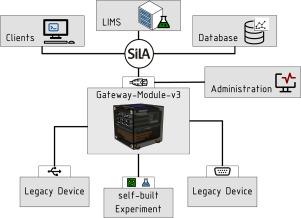Advancing IoT in the lab: Next generation Gateway-Module for laboratory device integration
IF 2.1
Q3 ENGINEERING, ELECTRICAL & ELECTRONIC
引用次数: 0
Abstract
This article introduces the next generation of the Gateway-Module, which is designed to simplify experimental setups and to further advance digitization. Based on the innovative work of Porr et al. in 2020, the Gateway-Module-v3 replaces the single board computer (SBC) with a Phytec i.MX 8M Plus (phycore-imx8mp) System on Module (SoM). This upgrade significantly reduces the physical size of the module to a compact 5.4 cm width, length, and height. Gateway-Module-v3 seamlessly integrates with standards such as Standard in Laboratory Automation (SiLA 2) and Open Platform Communication Unified Architecture (OPC-UA), advancing the digitization and efficiency of laboratory operations. At the center of its innovation is the tty2eth management module, which provides robust remote monitoring and maintenance using SSH and Prometheus metrics to ensure that experiments run smoothly even from remote locations. The Gateway-Module-v3 offers a wide range of connectivity options, including GPIO, USB and serial ports, making it adaptable to a variety of applications. Rigorous stress testing has confirmed its reliability and performance under demanding conditions, highlighting the suitability for both laboratory and remote scenarios. With its advanced functionality and connectivity, the Gateway-Module-v3 is ready to support researchers, advance their work, and will serve as a fundamental resource for current and future needs.

推进实验室物联网:用于实验室设备集成的下一代网关模块
本文介绍了下一代网关模块,旨在简化实验设置并进一步推进数字化。基于Porr等人在2020年的创新工作,Gateway-Module-v3用Phytec i.MX 8M Plus (phycore-imx8mp)模块系统(SoM)取代了单板计算机(SBC)。此次升级显著减小了模块的物理尺寸,宽度、长度和高度均为5.4厘米。Gateway-Module-v3与实验室自动化标准(SiLA 2)和开放平台通信统一架构(OPC-UA)等标准无缝集成,提高了实验室操作的数字化和效率。其创新的核心是tty2eth管理模块,该模块使用SSH和Prometheus度量提供强大的远程监控和维护,以确保即使从远程位置也能顺利运行实验。Gateway-Module-v3提供了广泛的连接选项,包括GPIO, USB和串行端口,使其适应各种应用。严格的压力测试证实了其在苛刻条件下的可靠性和性能,突出了实验室和远程场景的适用性。凭借其先进的功能和连接性,网关模块v3已准备好支持研究人员,推进他们的工作,并将作为当前和未来需求的基本资源。
本文章由计算机程序翻译,如有差异,请以英文原文为准。
求助全文
约1分钟内获得全文
求助全文
来源期刊

HardwareX
Engineering-Industrial and Manufacturing Engineering
CiteScore
4.10
自引率
18.20%
发文量
124
审稿时长
24 weeks
期刊介绍:
HardwareX is an open access journal established to promote free and open source designing, building and customizing of scientific infrastructure (hardware). HardwareX aims to recognize researchers for the time and effort in developing scientific infrastructure while providing end-users with sufficient information to replicate and validate the advances presented. HardwareX is open to input from all scientific, technological and medical disciplines. Scientific infrastructure will be interpreted in the broadest sense. Including hardware modifications to existing infrastructure, sensors and tools that perform measurements and other functions outside of the traditional lab setting (such as wearables, air/water quality sensors, and low cost alternatives to existing tools), and the creation of wholly new tools for either standard or novel laboratory tasks. Authors are encouraged to submit hardware developments that address all aspects of science, not only the final measurement, for example, enhancements in sample preparation and handling, user safety, and quality control. The use of distributed digital manufacturing strategies (e.g. 3-D printing) is encouraged. All designs must be submitted under an open hardware license.
 求助内容:
求助内容: 应助结果提醒方式:
应助结果提醒方式:


